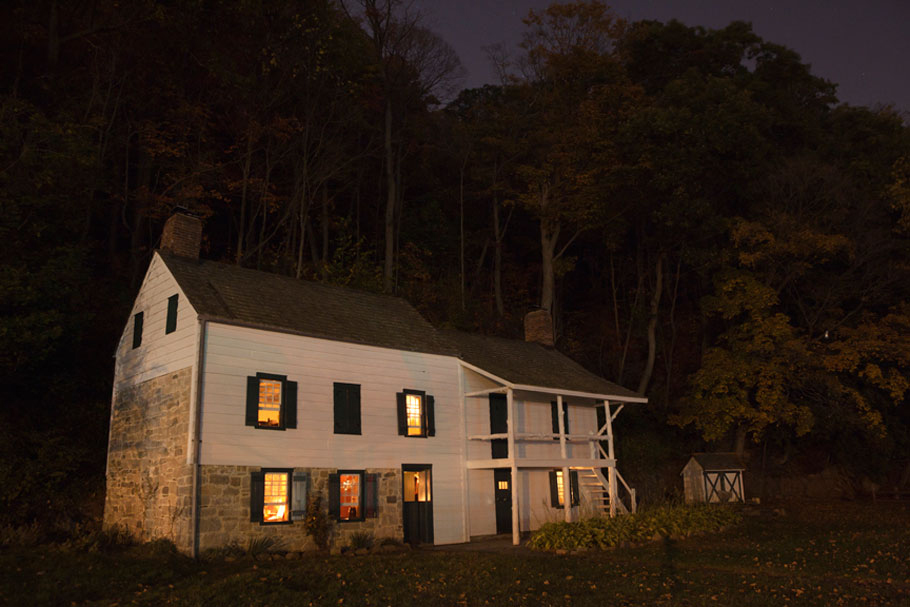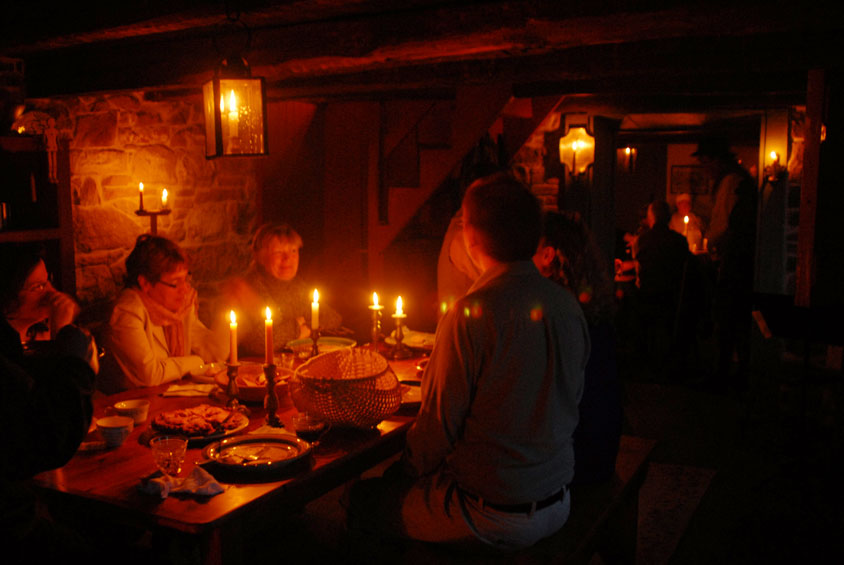Making a (Historic) House into a Home
A “Cliff Notes” Story
September 2006
At one point, there were about thirty people in the house, almost all of them in the two small rooms downstairs. We’d begun the evening as five staff dressed in nineteenth-century clothing, lighting candles and getting things ready. Then there came our twenty paying guests (in twenty-first-century clothing), as well as Mr. Thaddeus MacGregor, our “tavern musician,” in his corner with his top hat and guitar. Then, out of the blue, three or four of the crew of the sloop Clearwater, docked that evening at Alpine, happened to wander over to the house, curious what was going on. (This was minutes after we’d told our guests about how the crews of the sloops of old used to stop at this very place.) And then a woman came in who had been walking her dog by that afternoon — she’d asked us why we were opening up the house. Now she’d come back to see if what we’d told her was true: Were we really attempting to recreate a nineteenth-century Hudson River tavern at the Kearney House…?

The one thing most people comment on when they enter the house for the first time is how “small” it is. Indeed, by modern standards it can seem a tight space in which to live. Then we tell them that Rachel Kearney brought up at least nine children in this space — before they added on the northern half of the house around 1840 (each half, old and new, has two rooms — one downstairs, one upstairs — and an attic space, for a total usable floor space of around 1,500 square feet).
Then we tell them that Mrs. Kearney also ran a tavern here…
Even for us — some of whom have told about the nine children and the tavern more times than we’d probably care to admit — it could seem like something of a stretch. Until that evening. Until thirty people were in that space, their modern eyes adjusting to candlelight, and, yes, the house felt full — but it didn’t necessarily feel crowded. It’s one more lesson that the house has taught us over the past year, since we got the fireplaces restored and operating. How our perceptions of space — “living space,” “working space” — at least here in suburban New Jersey, have changed some over the generations since Mrs. Kearney ran a tavern from her house beneath the “Closter Mountain.”
Some of the other lessons the house has taught us have been more workaday. The house has shown us how we should arrange its furnishings, for one thing. Before we started doing our tavern programs (we call them “Punch & Pie at Mrs. Kearney’s Tavern” — see this page for upcoming “tavern” programs), we treated chairs and tables like props. “Where would this one look good?” we’d ask each other. But when you’re expecting twenty hungry and thirsty guests in an hour or two, the question becomes, “Where the heck are we going to put them all?” And the next morning, the furnishings would seem right. They were where they were supposed to be.
Since we’ve been cooking at the hearth on a regular basis (we cook on many Sunday afternoons now, dressed in our period garb), the house has also shown us how to arrange the kitchen and its tools and supplies. Before we cooked in the house, for example, we’d hung all our ladles and spoons and forks and so on across the front of the hearth because, well, because they looked cool hanging there, all spread out. Then you start cooking, and every time you bend down to stir a pot, you slap your face on a ladle or a spoon, and before you know it you’ve moved them out of the way to the sides of the hearth. Where they belong.
The house has also confirmed some of the things we’ve been telling people over the years, helping to move us beyond educated guess-work. The ceilings in the house aren’t low, we’ve been saying for years, because “people were shorter back then.” They were built that way because it made the house that much more efficient to heat. Now that we’re the ones splitting the firewood and hauling it inside, it makes blatant, obvious sense. We run fires only one or two days a week. But it’s that much easier for us to imagine what it must have been like to keep those fires going for months at a time, through all the long winter (and without the benefit of a chainsaw to get the wood to the proper length to split!). The low ceilings make perfect sense, even if someone in the family might have had to get used to ducking his or her head.*
Where should we place the candles? What about the spare candles? What’s the best arrangement for doing a lot of dishes?
We’ve also come to see certain items as particularly dear to our lives at our little home-away-from-home, and not always those we would have expected. A large, cast iron kettle that was donated to us last year now seems indispensable, for example. It holds about two gallons of water, which we can bring to a boil — if we’ve got our fire burning well — in about half an hour; when we pour some out, we immediately refill it. This is not for tea or coffee (we have smaller kettles for those), but for plain old hot water. (Think how many times in your day you turn a knob or push a lever for hot water. Or run a dishwasher or washing machine.)
Something else that people comment on now: the smell of the wood smoke in the house, the aroma of cooking. And so a house becomes a home.

We’re not kidding ourselves. We don’t live at the Kearney House. We’re not there day-to-day, four seasons a year, as was Mrs. Kearney for so many of her nine decades on this earth. But we are learning a bit more about what her life must have been like. And that’s the thing about the “living history” approach to historical interpretation, an approach we’ve adopted under the capable guidance and encouragement of John Muller and his talented staff at Fort Lee Historic Park: it has opened unexpected doors, for us and for our visitors and guests alike. It’s like having a chance to turn up a corner and peek behind the fallen curtain of the years. To see — and hear, and smell — even to feel — for a moment or two what used to be.
– Eric Nelsen –
*While it is true that people in this part of the world, on average, are a couple of inches taller than they were in Rachel Kearney’s day (much of it has to do with nutrition, including during prenatal development), taking that lower average height as the rationale for the low ceilings just doesn’t hold together. For one thing, humans have never come in standard sizes. Look at any old photograph or painting of a group of people, and you will see a wide range of heights. When you encounter a calculated average height for a past time period, then, it stands to reason that there must have been a considerable number of people who were quite a bit above (think Abraham Lincoln), or below, that average. Also, the scale is all wrong: if people were a couple of inches shorter, why then are the ceilings a couple of feet shorter than most ceilings today? (Even so, the great majority of our visitors today can stand in the house without having to duck their heads.)

